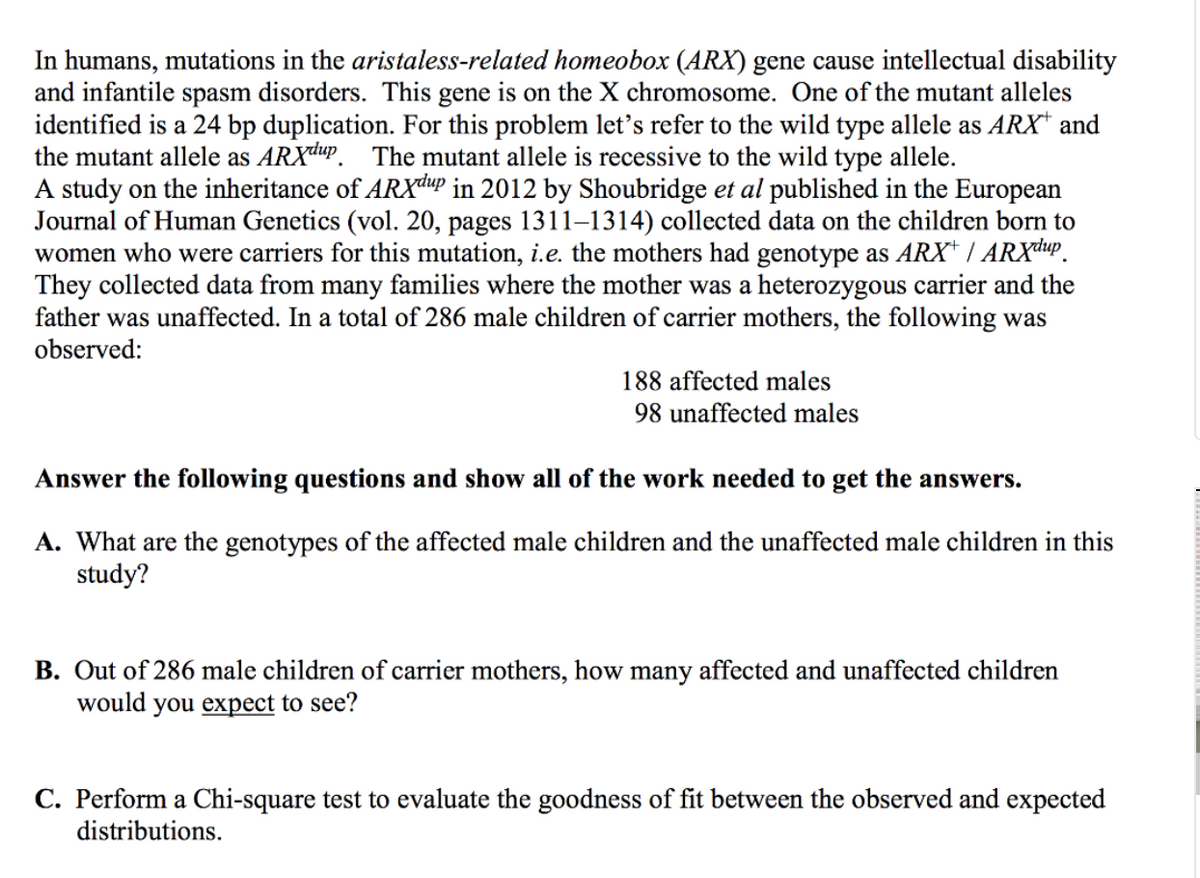In humans, mutations in the aristaless-related homeobox (ARX) gene cause intellectual disability and infantile spasm disorders. This gene is on the X chromosome. One of the mutant alleles identified is a 24 bp duplication. For this problem let's refer to the wild type allele as ARX* and the mutant allele as ARXdup. The mutant allele is recessive to the wild type allele. A study on the inheritance of ARXdup in 2012 by Shoubridge et al published in the European Journal of Human Genetics (vol. 20, pages 1311-1314) collected data on the children born to women who were carriers for this mutation, i.e. the mothers had genotype as ARX+ / ARXdup They collected data from many families where the mother was a heterozygous carrier and the father was unaffected. In a total of 286 male children of carrier mothers, the following was observed: 188 affected males 98 unaffected males Answer the following questions and show all of the work needed to get the answers. A. What are the genotypes of the affected male children and the unaffected male children in this study? B. Out of 286 male children of carrier mothers, how many affected and unaffected children would you expect to see? C. Perform a Chi-square test to evaluate the goodness of fit between the observed and expected distributions.
In humans, mutations in the aristaless-related homeobox (ARX) gene cause intellectual disability and infantile spasm disorders. This gene is on the X chromosome. One of the mutant alleles identified is a 24 bp duplication. For this problem let's refer to the wild type allele as ARX* and the mutant allele as ARXdup. The mutant allele is recessive to the wild type allele. A study on the inheritance of ARXdup in 2012 by Shoubridge et al published in the European Journal of Human Genetics (vol. 20, pages 1311-1314) collected data on the children born to women who were carriers for this mutation, i.e. the mothers had genotype as ARX+ / ARXdup They collected data from many families where the mother was a heterozygous carrier and the father was unaffected. In a total of 286 male children of carrier mothers, the following was observed: 188 affected males 98 unaffected males Answer the following questions and show all of the work needed to get the answers. A. What are the genotypes of the affected male children and the unaffected male children in this study? B. Out of 286 male children of carrier mothers, how many affected and unaffected children would you expect to see? C. Perform a Chi-square test to evaluate the goodness of fit between the observed and expected distributions.
Human Anatomy & Physiology (11th Edition)
11th Edition
ISBN:9780134580999
Author:Elaine N. Marieb, Katja N. Hoehn
Publisher:Elaine N. Marieb, Katja N. Hoehn
Chapter1: The Human Body: An Orientation
Section: Chapter Questions
Problem 1RQ: The correct sequence of levels forming the structural hierarchy is A. (a) organ, organ system,...
Related questions
Question
How do we get the expected?

Transcribed Image Text:In humans, mutations in the aristaless-related homeobox (ARX) gene cause intellectual disability
and infantile spasm disorders. This gene is on the X chromosome. One of the mutant alleles
identified is a 24 bp duplication. For this problem let's refer to the wild type allele as ARX* and
the mutant allele as ARXdup. The mutant allele is recessive to the wild type allele.
A study on the inheritance of ARXdup in 2012 by Shoubridge et al published in the European
Journal of Human Genetics (vol. 20, pages 1311-1314) collected data on the children born to
women who were carriers for this mutation, i.e. the mothers had genotype as ARX+ / ARXdup
They collected data from many families where the mother was a heterozygous carrier and the
father was unaffected. In a total of 286 male children of carrier mothers, the following was
observed:
188 affected males
98 unaffected males
Answer the following questions and show all of the work needed to get the answers.
A. What are the genotypes of the affected male children and the unaffected male children in this
study?
B. Out of 286 male children of carrier mothers, how many affected and unaffected children
would you expect to see?
C. Perform a Chi-square test to evaluate the goodness of fit between the observed and expected
distributions.
Expert Solution
This question has been solved!
Explore an expertly crafted, step-by-step solution for a thorough understanding of key concepts.
Step by step
Solved in 2 steps

Knowledge Booster
Learn more about
Need a deep-dive on the concept behind this application? Look no further. Learn more about this topic, biology and related others by exploring similar questions and additional content below.Recommended textbooks for you

Human Anatomy & Physiology (11th Edition)
Biology
ISBN:
9780134580999
Author:
Elaine N. Marieb, Katja N. Hoehn
Publisher:
PEARSON

Biology 2e
Biology
ISBN:
9781947172517
Author:
Matthew Douglas, Jung Choi, Mary Ann Clark
Publisher:
OpenStax

Anatomy & Physiology
Biology
ISBN:
9781259398629
Author:
McKinley, Michael P., O'loughlin, Valerie Dean, Bidle, Theresa Stouter
Publisher:
Mcgraw Hill Education,

Human Anatomy & Physiology (11th Edition)
Biology
ISBN:
9780134580999
Author:
Elaine N. Marieb, Katja N. Hoehn
Publisher:
PEARSON

Biology 2e
Biology
ISBN:
9781947172517
Author:
Matthew Douglas, Jung Choi, Mary Ann Clark
Publisher:
OpenStax

Anatomy & Physiology
Biology
ISBN:
9781259398629
Author:
McKinley, Michael P., O'loughlin, Valerie Dean, Bidle, Theresa Stouter
Publisher:
Mcgraw Hill Education,

Molecular Biology of the Cell (Sixth Edition)
Biology
ISBN:
9780815344322
Author:
Bruce Alberts, Alexander D. Johnson, Julian Lewis, David Morgan, Martin Raff, Keith Roberts, Peter Walter
Publisher:
W. W. Norton & Company

Laboratory Manual For Human Anatomy & Physiology
Biology
ISBN:
9781260159363
Author:
Martin, Terry R., Prentice-craver, Cynthia
Publisher:
McGraw-Hill Publishing Co.

Inquiry Into Life (16th Edition)
Biology
ISBN:
9781260231700
Author:
Sylvia S. Mader, Michael Windelspecht
Publisher:
McGraw Hill Education